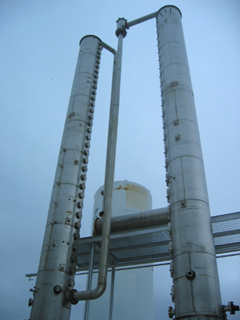Expired Beverages
Air Date: Week of May 6, 2005

Distillation towers of the New Companies plant where the beer will be boiled into alcohol/ethanol. (Photo: Lisa Ann Pinkerton)
Lisa Ann Pinkerton of WYEP in Pittsburgh continues our look at the new ethanol with a visit with two entrepreneurs who show you can make ethanol from old beer and soda.
Transcript
GELLERMAN: Well, despite questions about the use of ethanol, a growing number of entrepreneurs are betting on the future of making the alternative fuel out of all sorts of stuff and starting up ethanol refineries that don’t use corn. Lisa Ann Pinkerton of WYEP in Pittsburgh has the story of two enterprising men in Ohio who are about to start making car juice-out of expired “brewski.”
PINKERTON: There may still be debate on what happens to city air when ethanol is mixed with gasoline. Nevertheless, the Clean Air Act of 1990 continues to require smoggy cities to blend oxygenates into their gas. And at a gas station along the rainy, Ohio turnpike, drivers are none the wiser.
MAN: Isn’t that like corn substitute or something like that?
WOMAN: I have no idea about gas. All I know is I just fill up my car. I don’t know what’s in there.
STUDENT: I’m not sure to be honest with you.
SALESMAN: It doesn’t bother me one way or the other. I mean I’ve got to drive.
PINKERTON: As long as the Federal Government requires ethanol, Ohio will be a large purchaser. This reality combined with an idiosyncrasy in the beverage business made one group of investors see a future in stale beer and soda. Just outside of Cleveland, Liquid Resources recycles whole pallets of expired beverages, all the way from the cardboard and plastic to brew inside, which can be converted into valuable ethanol.
COOK: You know, what we used to do is just take it to the dump. And the dump's eating all the glass. It’s a landfill you know.
PERRY: The whole state of Pennsylvania and all of southern Ohio is doing exactly the same thing.
COOK: Yeah, right.
PINKERTON: Liquid Resources clients are people like Steve Cook of Knoll Beverage. He wholesales around two million cases to greater Cleveland each year. But if products expire before they’re sold, the state requires him to destroy the controlled substance if he wants to get his valuable excise taxes back. This means taking it to a dump or burning it at hazardous waste facility.
COOK: In terms of if it’s recycled, we’re not even sure.
PINKERTON: But at Liquid Resources, Cook can avoid bureaucratic red tape, get his taxes back sooner and better the environment all at the same time.
[SOUNDS OF WAREHOUSE, SAWING, CRUSHING]
PINKERTON: On the warehouse floor, amongst a sea of pallets, glass bottles are crushed and the liquid that was once useless appreciates in value as it trickles into a tank below.
[GLASS FALLING]
PINKERTON: The glass shards left over fall into a dumpster outside to be recycled. Yellow tubing, snaking across the warehouse floor, carries the discarded beverage to its new destiny. As Co-founder Tim Curtis follows it, he says the plant could convert anything made with corn syrup.
CURTIS: Colas, juices, pop tart filling--products like that that have sugar are great products for us.
PINKERTON: At the opposite end of the warehouse, Curtis props a door open with a rock, before stepping toward two towering distillation columns, about three stories high.
|
CURTIS: The steam heats the alcohol and the process of distillation happens as the lighter parts of those solutions, which is the alcohol that we want, rises to the top of these columns. And what is flowing out of the top of the second column is a very pure kind of alcohol. For a listener’s standpoint 198 proof, 199 proof ethyl alcohol, which is ethanol--that is of sufficient quality to be used as a fuel blend. PINKERTON: While Liquid Resources is happy to keep cans and bottles out of landfills, the idea to make ethanol out of wastes was purely a business decision. CURTIS: We were really compelled toward making ethanol from other people’s wastes. They’re always going to have to get rid of and therefore, would have an interest in paying someone like us to manage. PINKERTON: Once they finish calibrating their machines, Liquid Resources hopes to put around six million gallons of waste based ethanol on the market each year. But Daniel Sperling, head of the Institute of Transportation Studies at UC Davis, says moving away from corn-based ethanol won’t be easy. SPERLING: I think what we need is a redoubled effort to make sure that we do gradually make this transition from corn ethanol and perhaps we can adopt policies that are designed to do that. We don’t have that now. And so everyone takes the easy way out with the corn ethanol, even though, in the long term, it’s more expensive and uses more energy and produces more greenhouse gasses. PINKERTON: Just outside of Cleveland, this is Lisa Ann Pinkerton for Living on Earth. Living on Earth wants to hear from you!Living on Earth Newsletter [Click here]
Donate to Living on Earth! NewsletterLiving on Earth offers a weekly delivery of the show's rundown to your mailbox. Sign up for our newsletter today!
|






